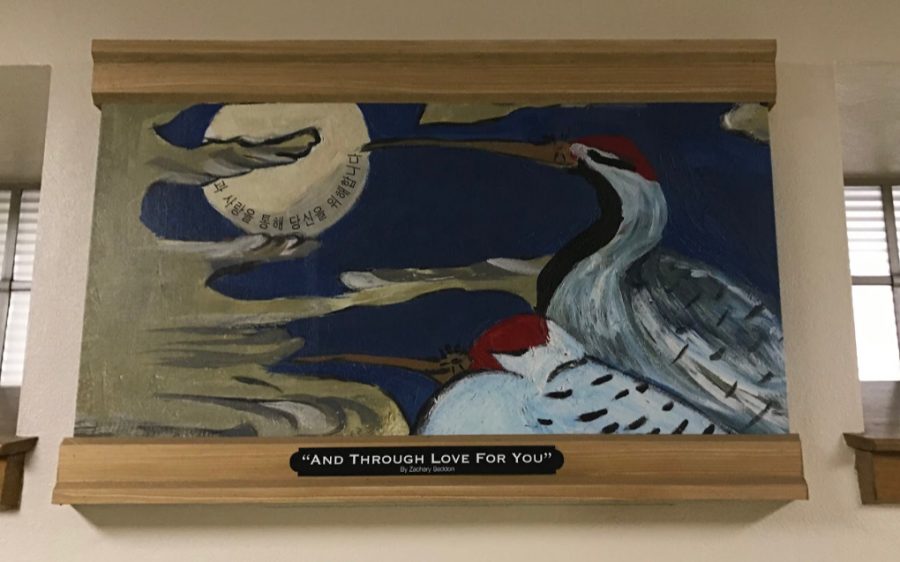The Art That Tells A Story Without Words
January 17, 2020
Visual art can be summed up as “a way for one to communicate without words.” From painting to graphic design, it is all-encompassing. Many may long to find it, but the students at Salesianum know exactly where it is. Indeed, it has been sitting in our hallways for almost a year – beautiful pictures that pay homage to the school community. This Salesian community is multi-faceted: some are star athletes, others acclaimed academics; some, however, have a natural gift for visual art. Senior Kyle Tichenell, senior Zach Seddon, and junior Nick Rapposelli, amongst others, all fit the profile of the artistically gifted. Each one has some sort of work in the hallway, which welcomes the new decade. Clearly, it stands the test of time.
The work provides for a colorful atmosphere, as each artist employed varying areas of interest. “[The artists] all took different takes on different styles,“ said Tichenell. In his case, he took inspiration from mainly Spanish speaking countries. He even paid homage to countries that lacked famous graphic designers, and took inspiration mostly from lesser known artists. What’s more, Seddon followed the example of Minhwa, traditional Korean art. Rapposelli concerned himself more with the issue of globalization, creating a poster calling for world peace. Summed up by Seddon, and present in each of them, one intended takeaway is “just how important ALL languages are.”
The credit for conceiving this idea goes to Mr. Magargal, who wanted to convey the work of his students in multiple classes. Needless to say, they supported his decision, and put their best foot forward with their creations. “I displayed this art because I had the opportunity to do it, so I took it,” commented Rapposelli. This initiative carried over to nuanced interpretations of their creations, including specific emphasis on displays in the language wing. “Language is something that’s not linear, it’s very creative, very subjective,” explained. Tichenell. “Countries that speak different languages, you look at them, and you see it’s so different how they look at things.”
Diversity aside, each took a similar approach in conceiving their work. They each agreed that trying to find an idea that resonates with the artist is “the most important thing.” Furthermore, “We all came up with, like, our ideas at one point; we were kind of at the same point along in the process. We would get our idea down, and they would start painting.” To do that, though, one has to wait for “that ‘eureka’ moment,” as Seddon put it. The process can take several weeks.
They all agree that they feel pride knowing that they contributed something. “I think it’s awesome, especially to have, like, our names on the wall in a project that will stay there for a couple years, maybe more.” It encourages others to take a stand and challenge the current displayed artists. “I feel proud. I’m immensely proud of the work I created and that sole fact that now it’s hanging up is just the added bonus,” said Seddon. “It is really cool that I can just walk around and see my art on the wall and know I made something good,” said Rapposelli.
All three have been passionate about visual art for several years. “I’ve always been into it, per se. I started drawing at an early age, and my parents encouraged me to make art,” says Seddon. “I do a lot of creative writing and 3D art and design out of school.” “I have taken art class every year since kindergarten except for sixth grade… I always enjoyed the classes I had throughout the years,” says Rapposelli. Titchenell had liked art early on, and eventually discovered graphic design in eighth grade by sheer chance. Needless to say, the rest is history. In the present, art continues to shape their lives. While working at Spicy Pig Cafe, Tichenell did “a lot of design work for them,” creating their cafe and to-go menus, as well as their franchise logo. Seddon frequently draws sketches at his work to “destress,” and dabbles in 3D art on his free time. They will likely pursue the artistic route later on in life in some capacity.
Regardless of future plans, the work represents timelessness of tradition in the newly arrived decade – a tradition for which the school strives. Salesianum can now establish itself as a breeding ground for artistic pursuits, as well as athletic and academic endeavors. Indeed, from the art a legacy will arise. The times may change, but their work will stay the same.

